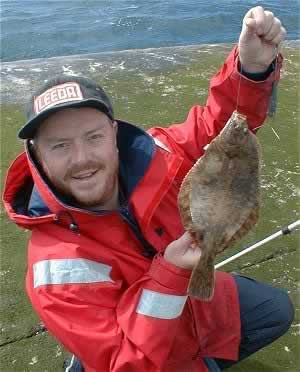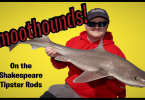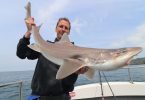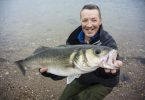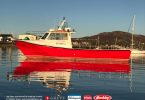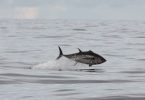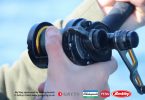More and more seaside councils are seeing the economic benefit and tourist pulling power that piers have. The derelict and decaying Victorian structures are being looked at in new light and being refurbished to their former glory to swell the ranks of existing piers.
This is good news for sea anglers, for piers are not just good places to begin your angling career on, but fished correctly actually produce consistently high returns of fish, as well as some big bass, conger and cod to boot!
FISH HOLDING FEATURE
Pier anglers, like their beach counterparts, tend to suffer from the long range bug under the misconception that the further they cast the greater the likelihood of catching both a quantity and quality of fish.
In reality, the main food holding area is right under the anglers feet around the pier supports themselves where mussels, crabs, shoals of sandeels, small pout, shrimps and sand worms like rag and lug mass together and create a full larder from which passing and resident fish sustain themselves.
Only if there is broken ground, mussel beds and kelp laying to the side of the pier that will hold some food is it worthwhile casting away from the pier.
Tidal action found on piers tends to work laterally, ie, it comes from side to side. This lateral action digs the sand out adjacent to the supports creating a deep gutter or trench that usually runs the full length of the pier. It’s here that mussels, limpets, and seaweed’s become attached to the exposed bases of the supports and form the basis of fishes interest.
The tides persistent scouring of the gully creates deep sandy pools and exposes rocks and boulders. These help break the flow of the passing tide, so small fish seek shelter in the deeper pools, and crabs hide in the rocks prior to feeding and when peeling.
This knowledge regards piers concentrating food directly underneath them also raises the question why many anglers insist on fishing the very ends of piers ignoring the middle section. Pier ends do fish well at times, but rarely will they compete with marks further in that put you over that concentrated food supply.

SPECIES
Running the gutter itself are conger, codling, bass, whiting, dogfish, flatfish, pout, rockling and coalfish.
Higher up towards the surface, but still tight under the pier will be mackerel, garfish, bass and mullet. Mackerel like to sit in the tide run created as water rushes past the piers extreme end. Bass prefer to hunt the inner sections for pout, sandeels and smaller mackerel. The mullet prefer feeding amongst the weed growths around the supports.
Sandbanks within a few yards of the structure should see plaice, whiting, dabs, and possibly sole resident. The only time casting should be considered is when there is a chance of thornback ray laying over clean ground directly out from the piers end.
METHOD 1: LEDGERING
Take a look along any pier and you’ll notice that most fisherman will be lined up on the downtide side. This is because they’ve realised that fishing the uptide side of the pier costs them tackle. What happens is that they cast into the tide, which then sweeps their tackle into the gutter and under the pier legs where it becomes snagged.
The disadvantage with fishing the downtide side is that the baits scent is carried away from all the fish feeding along the piers gutter and your catch results will be a small percentage of what they should have been.
It’s also a matter of natural presentation, too. The tide run carries natural food items like washed out lugworm, fish bits, dead crabs etc, with it. These wash and roll into the gutter adding further to the food count.
If you fish from the uptide side of the pier use a lead heavy enough to anchor and keep the bait just above the gutter, or far more effective is to choose a light enough lead to allow the bait to wash into the gutter where it will then hold. You have to risk the lead and rig, and losses can be heavy, though we’ll shortly look at how this can be minimised, but fishing the uptide side sees your scent trail washing down into the gutter and in to the direct path of the passing fish that will turn to eat the bait.
If you have to fish the end of the pier ad the ground is clean, cast well uptide with a plain lead and let the bait slowly work downtide in a wide arc. This covers a large area of ground and maximises your chances of coming across pockets of feeding fish. This is especially good at locating thornbacks, plaice and whiting feeding over sandbanks.
METHOD 2: FLOAT FISHING
Float fishing with a sliding float and small pieces of mackerel flesh, sandeel strip, ragworm etc, close to the tops of the pier legs will pull in a steady stream of small pollack, garfish and the odd mullet. But deliberately targeting mullet needs more work.
Try suspending onion bags full of mashed bread and a little mackerel flesh and let this just touch the water. Bits will fall out as the swell washes over the bag and create a scent trail for the mullet to follow which also sharpens their appetite.
Small stick floats or wagglers work well, but keep the shot weighted nearer the float so that the hook bait sinks fairly slowly and appears more natural.
PEAK FEEDING TIMES
It’s difficult to be specific about feeding times during tidal runs due to the wide variety of species and much depends on whether the pier has permanent deepish water under it’s feet, or if the gutter dries out at low water.
Given a reasonable permanent depth of water expect conger towards low and high water slack with the bulk of their feeding done over neap tides at night. Codling prefer some tide run and should be targeted during the bigger spring tides. Whiting follow a similar pattern.
Flatfish will feed on the neaps and slack water periods of spring tides. Bass show in numbers on the springs, but occasional double figure bass will come looking on the smallest neaps when food is scarce for them. Mackerel tend to be a permanent summer resident given a decent depth.
Piers that dry out around their base fish best during the middle hours of the flood, mainly for bass and flatfish only. Ebb tides are often very poor. Mullet are a permanent resident on both types, but generally prefer slack water times for actual feeding.
Aim to fish night tides for a
ll species except mackerel, plaice and mullet. High tides in the early evening can be good with fish moving in to mop up food scraps left by the day trippers and holidaymakers. The hour just prior to dawn is another special time. Daylight tides can give plaice, plus mackerel and mullet, but inquisitive passers by can make fish wary and shy to feed if the water is shallow.
TACKLE
Pier tackle is always a compromise. The best pier anglers do not use what are commonly described in tackle catalogues as pier rods. Normal 5-6oz beachcasters are favoured for their bite detection, and wisely, the extra length. A 12ft rod helps keep fish away from those pier supports.
It doesn’t matter whether you use a multiplier reel or a fixed spool, but gear strength is! Choose only reels with big, strong gears like ABU 7000’s, 9000’s, Penn’s etc, and the bigger fixed spool reels such as the Mitchell range.
Reels need to be loaded with 20 to 25lb breaking strain, even when few fish over 3lbs are expected. Should a big fish be hooked it will have to be held in the tide, away from the supports, until it tires and will need to be lifted if you’ve no other option, or better, worked towards a drop net. Heavy main line allows bigger fish to be hauled up hand over hand when fishing alone.
Conger and rays would require 25 to 30lb line, depending on tide strength and how rough the seabed is. Specialist big pier conger men deliberately go for a standard 30lb class boat rod and 40lb line for sheer pulling power that persuades most big eels to eventually leave the sanctuary of their homes.
Float fishing is far more delicate and requires an 11′ rod, 4lb line and a small fixed spool reel.
RIGS
When picking rigs, bear in mind that most of the fish you are trying to catch are feeding inside that gutter and tight to the seabed. Normal two and three hook beach rigs are not the best choice because they present one or two of the baits too high up in the water for consistent catches.
Most successful are flowing trace rigs, either armed with one hook for bigger fish, or two hooks for flatfish, etc.
The best rig for all species, except conger, is built as follows. Take 3ft of 60lb mono and tie in a loop of line at the base to take a length of weak line and the weight, the weak line breaking when the lead gets jammed. Tie in a blood loop to take the hook length, or add a bead trapped swivel, just above the first loop. This keeps the baits close to the seabed where the bulk of fish are.
The hook length needs to be 20 to 30lb breaking strain and some 2 to 6ft long for a single hook, or for a two hook trace take a 5ft length of 20 to 30lb line, tie a 2ft loop in the end cutting the loop to leave a short upper hook length about 6ins long and the long end about 18ins.
Hooks need to be strong to cope with lifting fish through mid air. Mustad Aberdeen 3261 BLN’s are ideal for flatfish and whiting, for codling and bass you’ll not beat a Mustad Viking 2/0 to 4/0, but you may need to consider the stronger O/Shaughnessy 4/0 to 6/0 for the conger.
A conger rig should have a swivel slid on to the main line by one eye only and then tie on another strong swivel. Add 2ft of 100lb plus line to the tied swivel and then the hook. The sliding swivel again has a very short length of weak line to take the weight which will snap free when snagged.
BAITS
Standard shore baits like lug and rag work, but peeler crab and mussel are more successful. Conger are partial to a fresh pouting fillet, as are bass, though the latter are keener on a small pout live bait. King rag is a good bait for daylight plaice. Mullet, garfish and pollack like mackerel flesh with no skin attached.
USING A DROP NET
Drop nets are the best way to land a fish from a pier. Problems are caused though by the tide run.
Add plenty of lead to the bottom of the net so that it sinks easily in the water and is less affected by the running tide. There are some metal drop nets marketed by Scotties on the Isle of Wight which have natural weight and prove more controllable in a tide run.
Aim to have the net sunk and waiting just below the surface bringing the fish to one side and slightly above the net, then letting the tide wash the fish back into the waiting net. As it does so, the netsman lifts the net allowing the fish to fall in to it.
BE SAFE!
It’s a fact that piers can fish very well during and just after storms, but be wary of large waves washing over the structure and do not risk your safety by climbing down after good fish unless you are securely tied to a solid support, even then think twice!
To read more of Mike’s work, please visit his excellent website www.worldseafishing.com

